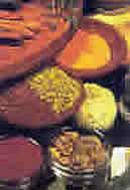Spices, A delicious tradition
In Latin America, many dishes cannot be made without the distinctive touch of spices. Pepper, chili, nutmeg, salvia, cinnamon or clove have enriched for years, the most delicious food of the Latin-American cuisine and though, many spices are not original of these countries, their culture and tradition have made of them, excellent and very cherished condiments, not only in the kitchen but also in the context of medicine.
Ancient Treasures 1492. What Columbus wanted was to find new routes toward the Indies, the so-called Moluccas Islands or Noluco, where he expected to arrive through the West, under the belief that the Earth was round. Five weeks later, he landed on the Guanahaní Island, one of the closest islands of The Bahamas, Haiti and Cuba with which he thought to have discovered a new route in the field of spice. Many unexpected events and mistakes made him lead one of the most fortunate and glorious enterprises in history: the discovery of the New World by mistake. During a second voyage, Columbus set sail again with the aim of finding gold and eastern spices; however, what he found was Jamaican pepper and vanilla. The precious treasures were cloves, nutmegs and cinnamon that were there cultivated and each country engaged in attaining the monopoly of the spice traffic which they knew that was a dependable source of wealth. But why spices have such a special attraction for them, products of such fragile appearance? Many of them were stimulants, others were used for therapeutic and pharmaceutical purposes; others as aromatic perfumes and enrapturing incenses, captivating oils and soaps.
Nutmeg, A Very Popular Tradition According to the popular tradition, a doctor that used to live in India, imported nutmeg for the first time in 1843, to improve and highlight Planter's Punch. Since then a better quality nutmeg is cultivated in Grenade whose taste is characterized for being one of the most aromatic, warm and sweet variety. The Portuguese preserve for a long time the secret of where this spice was cultivated until the Dutch expelled them from the Spice Island. One of the particularities is that weed never grows under the shade of this spice plant and that, according to the most enrooted beliefs, is a tree that love the smell of the sea. The delicate flower of this plant yields a round yellow fruit very similar to the peach.
When ripe, the fruit is divided into halves and the rind is dark red covered by an outer layer with the shape of a network and with a very intense red color. The hard rind has a seed which is known as nutmeg. The outer layer or red membrane is called macis, used as a spice, also highly valuable in the pharmaceutical industry. At present, the culinary use of this spice is very cherished and with it, exquisite dishes can be prepared either sweet or salty.
Add Spice to Your Life Its aroma is pleasant; its fragrance, special and its taste is hot. Pepper is another major protagonist of Latin-America cuisine. The historic tradition of pepper has equally served a large number of accounts and beliefs throughout centuries turning it into a valuable currency of exchange for many years, the protagonist of the most ambitious businesses of ancient times.
If we have a short look at history, we can observe that in several Sanskcrit texts, the use of pepper in the peoples of India is mentioned and it is believed that its introduction took place in Europe between the 6th or 5th century B.C. Jamaican pepper is a variety cultivated in Mexico, Guatemala, Belize and Jamaica and, according to history, it was not used for cooking nor medicinal purposes. The Mayan Indians used Jamaica pepper to embalm their dead before the Spaniards arrived in the West Indies.
Sea Fragrance A popular tradition and the art of cooking go hand in hand in the passionate world of spices. Cloves are equally linked to culture and popular beliefs since it is said that the people from the Moluccas or Spice Islands planted a clove to celebrate the birth of each baby. If the tree flourishes, that was a good presage for the newborn to whom a necklace of this spice was placed around his neck to protect it from evil spirits and diseases.
Chili is the star of the Mexican cuisine, like in many other dishes of the Caribbean and South America. The hot taste of chili revolutionized the kitchen in the tropical regions that were used to eat tasteless food as the mandioc in South America or haricot beans and beans in Mexico.
The true vanilla is very fragrant and its aroma have been described by many as sophisticated and evocative. Its taste corresponds to its aroma, softness and perfumed sweet. The fruit of the pomegranate has inspired many romantic peoples who describe it in legends as the tempting apple of the Garden of Eden. The Culture of Spice
For centuries, spices have been used in many cultures and civilizations. The Spice Route was a point of gathering and union of most varied peoples and cultures that made of them, coveted treasures, capable of competing with the most expensive and precious stones.






































































